Erica Vetsch's Blog, page 126
October 30, 2018
Giving Readers What They Want
guest, Candee Fick
Hello Seekerville! I'm so glad to be back with you today, and even though it's Halloween, I promise no tricks. Only treats. (Including an advance reader copy of my upcoming release!)
One of my delights as an author is hearing from readers. Especially when a storyline or character's journey has directly inspired or encouraged them through a difficult time. Whether it's direct to my inbox, online through social media, or shared inside reviews, I'm searching for those golden nuggets to know what resonated the most with my readers...and what fell short. That way I know what to repeat...and what to improve upon.
 JOURNEY INSIDE A BOOK – Book-1014197_1280,
JOURNEY INSIDE A BOOK – Book-1014197_1280, Creative Commons License from Pixabay
While stories are dear to my heart and come to life in my imagination first, this authoring adventure is all about giving readers what they want—an emotionally satisfying journey.The best stories include a journey that actually goes somewhere and has a logical point to the twists and turns along the way. A journey that tugs on a variety of emotions with an ebb and flow to the underlying tension. And a journey that leaves readers smiling in satisfaction at the end to know it ended perfectly without feeling rushed or drawn out.
 Available now
Available nowHowever, after publishing FocusOn Love back in February, for the first time I got mixed signals from readers. Some were glad I didn't nicely wrap up all the loose ends with my heroine's family because life sometimes stays messy and instead of easy answers, we can discover God's strength to forge a new future. Other readers clearly stated they couldn't wait for my next book to find out what happened.
The problem? That next official book in the series (featuring a secondary character) was already written and submitted to my publisher without any hint of a resolution for the previous heroine. And I had no logical reason to include an update during the editing process without making it feel forced and artificial.
But readers wanted to know! And since this business is truly driven by those who buy books, I decided to give my readers what they wanted. That true happily-ever-after ending without an unbearable wait until long after the next official book releases in May.
(Cue drum roll and shameless plug that Audra said I was allowed to include...)
 A Picture Perfect Christmas
A Picture Perfect ChristmasA Picture PerfectChristmas is the continuation of Liz and Ryan's story and is available for pre-order now before officially releasing on November 12th. Here’s the blurb:
From disowned to daughter to “I do?"
Freelance photographers Liz Foster and Ryan Callahan are finally making plans for their future. And what better time to get married than during the festive holiday season that brought them together?
If only Liz’s parents weren’t standing in the way of a picture-perfect wedding.
Spurred on by the ghosts of Christmases past, Dan Foster has already written Liz out of his will, so even attending the wedding—let alone walking his daughter down the aisle—is out of the question. However, this is the season for miracles and Ryan will do anything to make his bride smile.
What will it take to bring this family back together in time for the wedding?
If you like Christmas weddings, family reunions, and happily-ever-afters, then you’ll love this next chapter in The Wardrobe series.
But that's not all that's new in my life when it comes to storytelling and giving readers what they want...
(Psst. If you're a Christian writer looking for a publisher, pay attention. And if you love reading middle grade, young adult, romance, suspense, cozy mysteries, and/or seasonal stories with Christian messages...there are some amazing stories on the way.)
 Anaiah Press
Anaiah PressAs of this writing, I've been a Senior Editor at Anaiah Press for a month. In that time, I've had the privilege to evaluate incoming queries and submissions looking for that next emotionally satisfying story to recommend to our Acquisitions Board. I've also been elbow-deep in several contracted books helping other authors to hone, shape, and polish their ideas into a product readers will want to read.
So, if you'd like the specifics of what I'm looking for as an editor, check out my official introduction and wish list post . Or, if you'd rather, browse our upcoming releases to see if there's anything you'd want to read next.

Let's discuss: As a reader, what do you want in a story? And what do you do if it's lacking? Is it hard to articulate what's missing from a storyline?
As for those promised treats, I'm offering an advance reader copy of A Picture Perfect Christmas to a randomly drawn commenter. The rest of you can sample our virtual buffet of spiced apple cider, cinnamon rolls, pumpkin bread…and candy corn while we chat.
___
 Candee Fick is a romance editor for a small Christian press and a multi-published award-winning author. She is the wife of a high school football coach and the mother of three children, including a daughter with a rare genetic syndrome. When not busy editing or writing, she can be found cheering on the home team at sporting events, exploring the great Colorado outdoors, indulging in dark chocolate, and savoring happily-ever-after endings through a good book.
Candee Fick is a romance editor for a small Christian press and a multi-published award-winning author. She is the wife of a high school football coach and the mother of three children, including a daughter with a rare genetic syndrome. When not busy editing or writing, she can be found cheering on the home team at sporting events, exploring the great Colorado outdoors, indulging in dark chocolate, and savoring happily-ever-after endings through a good book.Where can you find Candee?
Visit her website www.candeefick.com
Sign up for her email list
Check out the rest of her books
Published on October 30, 2018 21:00
October 29, 2018
Blue Monday Open Critique
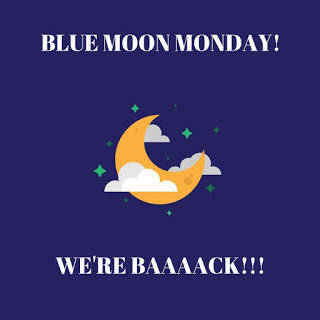 Blue Moon Monday is back! Open Critique Day! Let's all work on your stories!!
Blue Moon Monday is back! Open Critique Day! Let's all work on your stories!!Today if you came early to Seekerville it was SPOOKY!
So spooky you all oughta get a Snickers at the door!
But here I come, ghosting in to present
Blue Moon Monday!
Post a paragraph, the opening, the blurb, whatever you've got in mind and we'll talk, critique and make fun of RUTHY.
Because c'mon that's just fun.
Published on October 29, 2018 07:12
October 26, 2018
Weekend Edition

If you are not familiar with our giveaway rules, take a minute to read them here. It keeps us all happy! All winners should send their name, address, and phone number to claim prizes. Note our new email address and please send your emails to Seekerville2@gmail.com

Monday: Erica Vetsch posted about Writing Deadlines and how to keep them!
Wednesday: Publishers Weekly Bestselling Author Debby Giusti blogged about "Writing a Saga" with photos and historical facts about St. Augustine. Thanks to all who brainstormed characters that could be included in a Michener-like story set in the coastal city. The winner of AMISH CHRISTMAS SECRETS , the fourth and final book in Debby's Amish Protectors series, will also receive a book on St. Augustine and a small journal. Congrats to Library Lady for winning Debby's giveaway!
Friday: Pam Hillman offered brainstorming advice as she Puzzl(ed) Out A Story, One Piece At A Time.

Monday: Blue Moon Monday is back! Open Critique Day! Let's all work on your stories!!
Wednesday: Candee Fick will be our guest talking about giving readers what they want. In addition to sharing her manuscript wishlist as a new romance editor, she’s also giving away an advance reader copy of A Picture Perfect Christmas. Friday: There's excitement in Seekerville as we welcome back Seeker, Julie Lessman! Don't miss this exciting day as Julie delights as as only Julie Lessman can :)

Debby Giusti will be chatting on Harlequin Connection, Tuesday, OCT 30, at 1 PM. Stop by to say hello. You'll find the Facebook site here: https://www.facebook.com/groups/Harle...
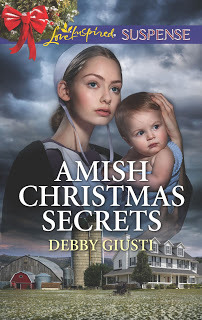
AMISH CHRISTMAS SECRETSis still available at Walmart,at your favorite book store and on Amazon.
Debby Giusti was the Love Inspired Authors and Readers Group hostess WED - FRI of last weekand gave away more than 20 books.If you read Love Inspired and Love Inspired Suspense stories,be sure to join this active and fun Facebook group!https://www.facebook.com/groups/LIAut...

Estate Planning Series from Kristine Kathryn Rusch.
APODs-Priorities - Getting Started by Amanda Cabot at Thyme for Writers
How To Write When Everything Goes Wrong by Allie Pleiter at An Indie Adventure
Time Traveler-- at Merriam-Webster. Put in a date and find out what words came into usage then.
10 Ridiculously Simple Steps For Writing A Book by Jeff Goins at Goins, Writer
Published on October 26, 2018 21:00
October 25, 2018
Puzzling Out a Story One Piece at a Time

by Pam Hillman
Each story idea starts with one tiny little puzzle piece. Just one.
A word, a photo of days gone by, a scent, a location, an event. Before my Natchez Trace Novel series became the full-fledged series that it is now, it was just a single thought to write about an indentured servant, which became the premise for the first book in the series, The Promise of Breeze Hill.

One idea. One Nugget. What might that be? It might be a character who can’t walk away, but then later doesn’t want to walk away, which, ironically, seems to fit all my heroic heroes. (Hmm, am I sensing a theme?) And, since I like to put a bit of a twist on my stories, I wanted the hero to be the one who was the indentured servant.
And to make matters worse, I indentured the poor guy to the heroine , but something in his past makes this a really bad thing. I just kept tightening the ropes on him. I also wanted my indentured servant to be an alpha male, with a take-charge attitude. More thinking outside the box turned Connor into a man who has already served a forced seven year indenture, but willingly indentures himself to pay for his four younger brothers' passage from Ireland.
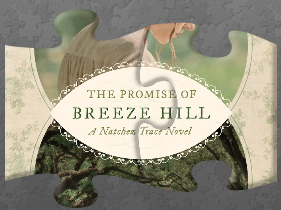
What would make Connor so adverse to be under the thumb of a woman...something more than just be an alpha male in a time period when women had little say in how things were run? What baggage and problems can I throw at Isabella Bartholomew? And what power (big grin) can I give her? What can push them apart, but draw them together? On and on and on, the pieces just keep falling in to place.
And it all started with the germ of an idea to write about an indentured servant.
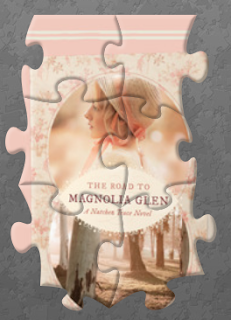
Oddly enough, or really not so odd, The Road to Magnolia Glen, the second book in the series started the same way. The good news was that I had an overarching series "theme" by this time. All I had to do was make Connor's younger brother a man who'd had to tend to his family back in Ireland for many years and he felt like he'd missed out on life.
Knowing that was not much more than picking out all the edge pieces to a jigsaw puzzle and putting the "frame" together. I mean, it's pretty easy to find the edges, but a lot harder to drill down and match up all the interior pieces. AND... here's the thing... we don't have a picture to go by. We're working blind, piece by piece.
But us authors are brave and determined if nothing else. And sometimes we carve a few pieces and make them fit. Ahem.
I built Quinn and Kiera's story the same way I built Connor and Isabella's, one piece at a time. I have a hero who, while he loves his brothers, (thinks he) wants to shuck his responsibilities and strike out on his own; a heroine who's doing everything in her power to keep her sisters together. One piece leads to another, and, well... their lives change.
Do you enjoy puzzles? Try this one on for size. :)
The groundwork for Caleb O'Shea, the hero in The Crossing at Cypress Creek (Spring/Summer 2019) was laid in the first two books, but it was almost as vague as the gray backgrounds in the puzzles above. Caleb the black sheep prodigal of the family. All I really knew was that he had to show up in Natchez and he had to be really tough. I knew nothing about Alanah Adams (I didn't even know her name) until I turned in book #2 and turned my attention to book #3. But I love Alanah.
And the women they are bound to protect with their lives: Isabella, Kiera, and Alanah? Each had to fit the heroes and they do. I'm not sure if they chose each other or if I did all that matchmaking by myself. I'm just glad all three couples ended up perfectly matched!

Let's talk. Authors, what's the first thing you come up with for a story? Is it the big picture, like the edge piece, a corner, or some obscure little thing that readers might not pick up on until the end of the book/series. Would you say you approach a jigsaw puzzle the same way you approach planning your books.
Readers, what catches your attention in a story first? Also, do you enjoy jigsaw puzzles? Where do you start with those? Do you pick out all the border pieces, or start with a focal point, like bright colors or a red barn or fall trees?
www.pamhillman.com
Published on October 25, 2018 21:00
October 23, 2018
Writing a Saga
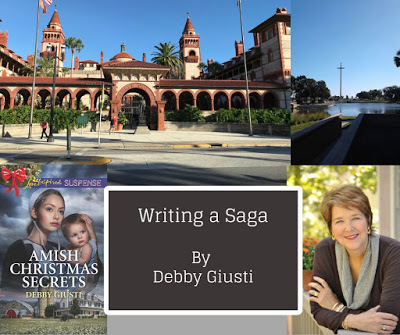
By Debby Giusti
Growing up, I loved to read James Michener’s stories. His books were epic sagas, some more than 1,000 pages long. The stories spanned generations and traced the history of not only his fictional characters but also the setting in which each of the stories took place. Hawaii was a favorite of mine, along with The Source, Centennial, Chesapeakeand Caravans.
 The old city gates of St. Augustine.Readers today favor shorter reads, and I daresay most publishers would probably reject a submission as expansive as Michener’s work. Although if an excessively long manuscript was particularly engaging, an editor might encourage the writer to cut the large work into a number of stories that could be marketed as a series.
The old city gates of St. Augustine.Readers today favor shorter reads, and I daresay most publishers would probably reject a submission as expansive as Michener’s work. Although if an excessively long manuscript was particularly engaging, an editor might encourage the writer to cut the large work into a number of stories that could be marketed as a series. Shops along the historic district in
Shops along the historic district inSt. Augustine.My husband and I spent last week touring St. Augustine, Florida, the oldest continuing European-established city in the New World. With its 453 year history, St. Augustine would be the perfect setting for a saga or series of stories. I’ll share some of the information I learned, then let’s brainstorm story ideas and characters who could be featured in a Michener-like saga or a series of interrelated stories set in the historical city.
 The stones Ponce de Leon arranged in the shape of the
The stones Ponce de Leon arranged in the shape of thecross when he landed in La Florida.Juan Ponce de Leon explored the coast of Florida and went ashore near St. Augustine in 1513. He named the area La Florida after the beautiful flowers growing there. The local Timucua Indians, who welcomed Ponce, were thought to get their stamina and strength from drinking the fresh, crystal clear spring water later dubbed “The Fountain of Youth.”
 A statue of Ponce de Leon in front of the Lightner Museum,
A statue of Ponce de Leon in front of the Lightner Museum, formerly the Alcazar Hotel. The famed explorer was
only 5' 2" tall.In 1565, the Spanish monarchy tasked Admiral Pedro Menendez de Aviles with establishing a defensive post in the New World. On September 8 of that same year, he landed in Florida and named the area St. Augustine after St. Augustine of Hippo, whose feast day had fallen a few days earlier. A Catholic priest traveling with Menendez celebrated Mass and consecrated the land to God. Following the service, a Thanksgiving dinner was served to the families and soldiers traveling with the admiral as well as the Timucua Indians, who warmly embraced the newcomers. Each of the Florida historians with whom we spoke pointed out that St. Augustine was founded years before Jamestown and Plymouth. They also boasted that the first Thanksgiving meal took place in Florida.
 The spot where Menendez came ashore and the site of the first
The spot where Menendez came ashore and the site of the firstCatholic Mass celebrated in the New WorldSpain wasn’t the only country interested in La Florida. Britain and France also vied for control of the coastal peninsula. They warred against the Spanish, and each time the area was overtaken by a new contingent, St Augustine was burned and the inhabitants fled. Sir Francis Drake attacked and plundered the settlement in 1586. Thirteen years later, a fire caused untold destruction, followed by a hurricane in 1599 that flooded the town.
 The Castillo de San Marcos
The Castillo de San MarcosIn 1672 the Spanish began construction of the Castillo de San Marcos, a fort made of newly discovered coquina, quarried on Anastasia Island. Made up of shells, the porous coquina withstood cannon fire and provided a sturdy, fire-resistant fort for the Spanish.
 The Oldest House, St. Augustine. Archaeology shows continuous
The Oldest House, St. Augustine. Archaeology shows continuous occupancy of this site from the 1650s to the present day.
The oldest house in St Augustine with continuous occupancy dates from the 1650s. A fire destroyed the structure in 1702, but it was quickly rebuilt and occupied by the Gonzalez family, who lived in the two-room dwelling with their ten children. In 1763, Joseph and Mary Peavett bought and expanded the home and turned the first floor into a tavern and general store. In addition to running their businesses, Mary was the midwife in town, and Joseph worked at the military barracks located across from their tavern. After Joseph’s death, Mary remarried a much younger man who ran through her money before he died. Mary lived her final years on land she owned outside of town. Interestingly, Eugenia Price fictionalized her story in the book, Maria.
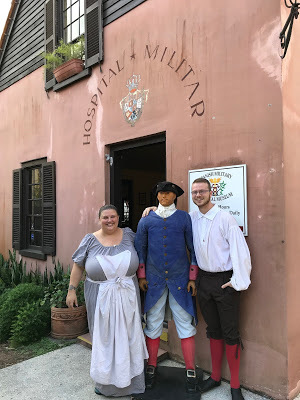 The Spanish Military Hospital
The Spanish Military HospitalA tour of the Spanish Military Hospital provides an interesting look at the medical practices of the late 1700s and early 1800s. Ambulation was performed on wounded limbs to prevent gangrene, which if left untreated would lead to sepsis and death. An arm could be removed in 2 to 3 minutes and a leg in 4 to 6 minutes. Speed was important to minimize blood loss and to keep the patient from going into shock.
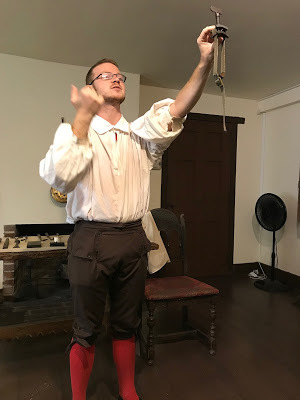 A newly developed vice-like tourniquet
A newly developed vice-like tourniquetdeveloped in France
clamped off the flow of blood.While only 30% of patients survived surgery in most medical facilities at the time, the Spanish had a 70% to 75% survival rate due to the sanitary procedures they routinely used. Bacteria had not yet been identified, but the surgeons washed their hands and instruments between operations. Patients’ soiled clothing was laundered soon after they arrived at the hospital. The floors were scrubbed with hot water and vinegar, and the mattress tick, or covering, was washed and the Spanish moss filling burned and new boiled moss inserted for each new patient.
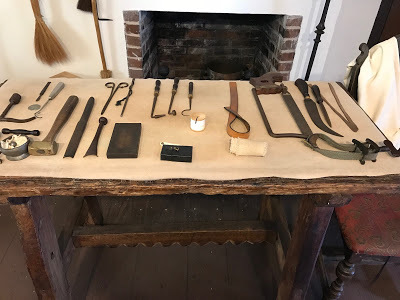 Surgical instruments.
Surgical instruments.The apothecary next door stocked horehound and mustard seed for coughs, white willow bark (from which aspirin is derived) to ease headaches, cloves for toothaches, rose hips for scurvy and ginger for nausea. Medicinal herbs grew in the nearby garden, such as comfrey, a long-leafed plant that looks somewhat like a hosta. The leaves of the comfrey plant were wrapped around sprained legs or ankles to decrease swelling and inflammation.
 The Apothecary.
The Apothecary.In 1819, the Spanish ceded Florida to the United States, and in 1845 Florida became a state. Fast forward to the 1880s when wealthy industrialist Henry Flagler, a partner with John D. Rockefeller in Standard Oil, built the grand Ponce de Leon Hotel in St Augustine. The very rich wintered there from January to Easter for a sum of $3,000. Across the street, Flagler built the Alcazar Hotel for middle-class vacationers. The smaller hotel had a spa, sauna and the largest indoor pool in existence at that time. Guests of the Ponce could use the Alcazar facilities, but the less wealthy were not allowed access to the Ponce.
 The Ponce de Leon Hotel with its Spanish Renaissance architecture.
The Ponce de Leon Hotel with its Spanish Renaissance architecture.The hotel was built and decorated within 18 months.
The Ponce closed in 1967 and is now the home of Flagler College. The guest accommodations were converted into dorm rooms, and the students eat in an ornately decorated dining hall where the wealthy in times past socialized. The Alcazar currently houses the Lightner Museum.
 Beautiful Tiffany glass windows in the dining room.
Beautiful Tiffany glass windows in the dining room.Flagler ate in this section of the room when he dined at the Ponce.
Close friends and people of prominence had the privilege of sitting near
his table.Today St. Augustine is a bustling college town with an interesting historic district. Cross over Lion Bridge to Andalusia Island and St. Augustine Beach where the lighthouse—towering 165 feet above sea level—helps sailors navigate the coastal waters. Constructed in 1874, the first lighthouse keeper fell to his death while painting the structure. His wife continued to man the lighthouse for years following her husband’s tragic accident. One of the subsequent lighthouse keepers and his wife enjoyed entertaining and their pretty daughters were known to attract the eye of many handsome young men, providing more fodder for our saga.
 The exquisite cupola in the entrance of the Ponce de Leon Hotel,
The exquisite cupola in the entrance of the Ponce de Leon Hotel,now Flagler College.Where should our story begin? At Menendez’s landing with the families who sailed with him from Spain? Or with the Timucua Indians who welcomed Ponce de Leon? Should we add a swashbuckling pirate or two that sailed the coast and came ashore at times to ransack the town?
 The St. Augustine Lighthouse. Yes, I
The St. Augustine Lighthouse. Yes, Iclimbed the 219 steps to the top.Let’s weave the various cultures into an interesting mix of characters. A Spanish innkeeper’s barmaid who loves a British soldier. A blacksmith interested in a wealthy landowner's daughter.
 The ladies parlor in the Ponce. Einstein wired the hotel with
The ladies parlor in the Ponce. Einstein wired the hotel withelectricity and created the ornate clock sealed in the fireplace
over the mantel.Would the Spanish surgeon at the military hospital fall in love with his hard working nurse? Or would he have eyes for the Colonel’s daughter? Shall we include a young woman who longs to apprentice at the apothecary? Who’s standing in her way? One of the doctors or a suitor who longs to apprentice as well?
 The fountain at the entrance to the Ponce. The frogs
The fountain at the entrance to the Ponce. The frogsform a sundial. The photo was taken at 10 AM.
Can you see the sun's shadow showing the time?As our saga moves forward, would we include a woman staying at the Alcazar Hotel who meets a wealthy playboy while strolling through the park? He is a guest at the Ponce. What happens when he invites the lovely lady to dine with him at his posh hotel? More than a few eyebrows would be raised for sure.
 More Tiffany glass windows in the Ponce Hotel.
More Tiffany glass windows in the Ponce Hotel. Tiffany was a new designer at the time and his
work at the hotel brought him much acclaim.I’ve only touched on St. Augustine’s rich past and hope history buffs will provide additional information that could embellish our St. Augustine saga.
 Share your ideas. Anyone who comments will be entered in a drawing for the fourth and final story in my Amish Protectors series, AMISH CHRISTMAS SECRETS. The winner will also receive a book about St. Augustine and a small journal.
Share your ideas. Anyone who comments will be entered in a drawing for the fourth and final story in my Amish Protectors series, AMISH CHRISTMAS SECRETS. The winner will also receive a book about St. Augustine and a small journal.Wishing you abundant blessings!
Happy writing! Happy reading!Debby Giustiwww.DebbyGiusti.com
 AMISH CHRISTMAS SECRETSBy Debby Giusti
AMISH CHRISTMAS SECRETSBy Debby GiustiSafe Haven for the HolidaysThe thrilling Amish Protectors conclusion
Leaving the nursing home where she works, Rosie Glick’s accosted by a man demanding incriminating evidence her murdered boyfriend stole—until Ezra Stoltz scares him off. Now with a killer dead set onsilencing the Amish single mother, Ezra must hide Rosie and her baby to keep them safe. But can he expose a sinister conspiracy in timeto save the woman he secretly loves?
Order here!
Watch forAMISH SAFE HOUSEFeb 2019Pre-order here!
Published on October 23, 2018 21:00
October 21, 2018
Managing Deadlines
 Tick. Tock. Tick. Tock.
Tick. Tock. Tick. Tock."As sands through the hourglass, so are the days of our lives..." (Okay, I probably just showed my age with this one. Bonus points if you can cite this reference in your comments.)
Writing deadlines.
The pre-published crave them. The oft-published deal with them. The smart writer plans for them.
But how? What steps can an author take to ensure that she makes her deadlines consistently and endears herself to her editors?
1) Be Honest. Be honest with yourself. When that contract offer comes in and everything is shiny and possible, it's easy to commit to a deadline that is unrealistic. Take a deep breath, truly evaluate your schedule, your obligations, and your writing capabilities. Take the time of year into account, holidays, vacations, school events, etc. For me, I avoid January 1st deadlines because I am the bookkeeper for the family business, and the last two weeks of December are slammed for me as I finish up responsibilities and meet with the accountant, etc. I also take into account things I love. Like March Madness. As a rabid Kansas Jayhawks fan, I know I will be glued to the TV to watch their progress as they make yet another DEEP run in the tournament. (Note my total confidence!) Also, reckon for your writing style. Are you a fast-draft kind of writer? Plotter, pantser? Blitzer? Teaser? How fast do you normally write? Can you realistically knock out a quality 90K word novel in three months? Or will it take you four, five or six? Are you a one-book-per-year author? Be honest in your evaluation, because you want to love the process of writing, not be all stressed out and cranky because you've set yourself a nearly-impossible task.

2) Plan Some Down Time. If you have X amount of words and Y number of days to your deadline, don't divide to get exactly how many words you need and assume you will do that every day over your writing period. Plan in days when you know you won't be able to write, or days when you don't plan to write at all. Your brain needs some time to refuel and relax in order to create your best stuff. Factor in interruptions, illness, and the unexpected and give yourself some wiggle room.
3) Plan Some Writing Marathons. Especially in the beginning and at the end of your story, when you know how things are going to unfold with your plot. Get a lot written up front and at the end when you tend to write faster because you know how the story needs to finish. Some writers take a weekend or two away to really pound out the words. If this isn't feasible for you, sequester yourself away from family and obligations to focus on your work. Hire a babysitter, send the kids to grandma's, trade weekend babysitting with someone. Get your family on board with your need for solitude and then crank out the words.
4) Set Goals. If you sit down every day with no expectation of what you're going to accomplish, chances are, you're not going to get as much done as you had hoped. Choose a word goal, or a scene goal. Aim for something that will stretch you, and then sit down and do it! The doing it is the most important part here. It's fine to set goals and talk about goals and all, but you have to actually do the work in order to accomplish them. It's like the old "I want to write vs. I want to have written." You can't just dream about making your deadline, you have to actually strive to do it.

5) Plan your Daily Life. Make meal menus, shop in bulk, prep meals ahead. Group your errands, set aside a time to blitz-clean your house. Get as many ducks in a row as you can ahead of time so you're not having to break away from your story just as the words start to flow. A little organization up front can make a huge difference. And don't be afraid to say 'no' to some requests for your time. Treat your deadline as inflexible. There will be obstacles and barriers to your perfect writing time. Treat those as challenges to work around and through and don't make excuses.
6) Realize Your Deadline Isn't About Just You. Publishers set deadlines in their contracts because they have many, many plans to make regarding your novel. There are so many steps that have to happen after you turn in your book, and they have to happen in a timely and organized manner. Several rounds of edits and rewrites, proofing, typesetting, printing, cover design, marketing plans, publicity plans, and so much more. Until your book is in their hands, most of these things can't really get going. If you're late with your work, it pushes EVERYTHING back. And, you will get a reputation as an author that cannot be relied upon to keep her word. Don't get me wrong. Life can and will interfere with your plans, and sometimes missing a deadline is unavoidable. But you must do everything realistically possible to hold up your end of the bargain.
7) Communicate. Tell your agent and your editor where you are with the manuscript, keep them up to speed. If it looks like you're going to need an extension, let them know as soon as you can. Don't wait until midnight on the day your ms is due. And don't 'go dark' hoping they won't remember about your story's due date.

I'm currently on deadline. December 1st my story The Accidental Earl is due. Knowing I would have family visiting for two weeks in October, I really hit my writing hard in the lead-up. When Nov. 1st rolls around, I'll have 30 days to finish. My family has been great, taking over shopping and cooking chores and generally not complaining about me writing into the early evening. They're troopers!
Deadlines can be intimidating, exhilarating, and extremely motivating. But meeting them won't happen by accident. But with a little planning and some hard work, you can meet your deadlines without drama.
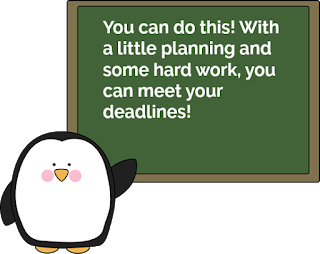
Question for you: How do you respond to deadlines? Do you dread them or relish them?

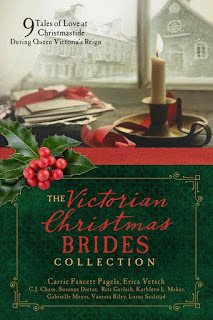 Best-selling, award-winning author Erica Vetsch loves Jesus, history, romance, and sports. She’s a transplanted Kansan now living in Minnesota, and she is married to her total opposite and soul mate! When she’s not writing fiction, she’s planning her next trip to a history museum and cheering on her Kansas Jayhawks and New Zealand All Blacks. You can connect with her at her website, www.ericavetsch.com where you can read about her books and sign up for her newsletter, and you can find her online at https://www.facebook.com/EricaVetschAuthor/ where she spends way too much time!
Best-selling, award-winning author Erica Vetsch loves Jesus, history, romance, and sports. She’s a transplanted Kansan now living in Minnesota, and she is married to her total opposite and soul mate! When she’s not writing fiction, she’s planning her next trip to a history museum and cheering on her Kansas Jayhawks and New Zealand All Blacks. You can connect with her at her website, www.ericavetsch.com where you can read about her books and sign up for her newsletter, and you can find her online at https://www.facebook.com/EricaVetschAuthor/ where she spends way too much time!Melisande Verity, works at Garamond's, and she's won the commission to create the perfect Christmas window displays for the season, and hopefully to win the store the prestigious Victoria's Prize. If she does, perhaps she can earn enough money to send her younger sister to music school....and just perhaps, she might catch the notice of her boss, Gray Garamond.
Gray is not convinced that Melisande is the one for the job, but he's resigned to his grandfather's choice. When the elder Mr. Garamond suffers a stroke, Gray takes charge of the store, and the old man asks Melisande to show Gray the true meaning of Christmas, that it isn't profits and sales, but rather the people that matter.
Available HERE: https://amzn.to/2IQkTcR or wherever you shop for fine Christian Fiction.
Don't forget...Books make great gifts, and Christmas books make GREAT Christmas gifts!
Published on October 21, 2018 21:00
October 19, 2018
Weekend Edition

If you are not familiar with our giveaway rules, take a minute to read them here. It keeps us all happy! All winners should send their name, address, and phone number to claim prizes. Note our new email address and please send your emails to Seekerville2@gmail.com

Monday: Jan Drexler shared her thoughts on What Are Your True Goals? The winner of a copy of The Sound of Distant Thunder is Pat Jeanne Davis.
Wednesday: Laurie Tomlinson dropped by to rehash the basics of branding. Winner of her novella That's When I Knew is Kim Hansen!
Friday: Winnie Griggs took a moment to share some beautiful photos and thoughts of her son's wedding. Hooray for the mother/son dance!! Okay, back on task now. Winnie gave some tips to think about when crafting scenes in her marvelous post, A Personal Note and Tips for Adding Vivid Detail. The winner of a copy of the re-release of her book, The Christmas Journey, is Caryl Kane.

Monday: Erica Vetsch will be talking writing deadlines and some tips on how to make keeping them easier!
Wednesday: Publishers Weekly Bestselling Author Debby Giusti blogs about writing sweeping sagas that span generations with a look at St. Augustine as the setting. Leave a comment to be entered in the drawing! Friday: Pam Hillman will be your very special hostess!

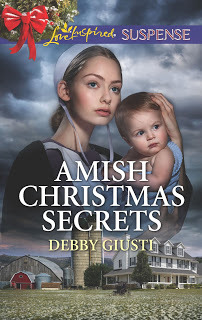 Congrats toDEBBY GIUSTI!
Congrats toDEBBY GIUSTI!
Amish Christmas Secrets made the Publishers Weekly Bestsellers List!
 Fabulous bookish articles on the blog at Hope by the Book this week
Fabulous bookish articles on the blog at Hope by the Book this weekAND
Ruthy's new release At Home in Wishing Bridge earned a Bookmarked Review!

Use code BOOKISH to save $4 on an annual subscription!
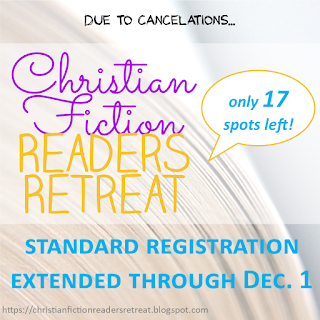
Due to cancellations, standard registration for #CFRR2019 has been extended through December 1. Tell all your bookish friends! There are only 17 openings remaining.

Best Christian Audio (website with compilation of audio Christian romance books)
Words are Radical! (or How to Cherish Language) by K.M. Weiland at Helping Writers Become Authors.
Phishing Scam Seeking Manuscripts Spreads Worldwide by Ed Nawotka at Publishers Weekly.
Marketing Advice Roundup: Best of the Last Year by Jane Friedman
Writers Beware of the Legal Pitfalls - Copyright Basics Part II by Karen Van Den Heuval at Thyme for Writers
Published on October 19, 2018 21:00
October 18, 2018
A Personal Note and Tips for Adding Vivid Detail
Hello everyone, Winnie Griggs here. I hope you'll excuse me while I indulge in a bit of personal reflection before I get to the actual writing-related part of this blog..

My son got married this past Saturday, and it was an absolutely beautiful celebration. The bridal party included, among others, my three daughters and the bride's sister as bridesmaids, one of my son-in-laws as a groomsman, my two grandsons as ushers and my other son-in-law, a preacher, performed the ceremony, so it was very much a family affair.
The ceremony itself was biblically based, with wonderful touches of personalization and light humor sprinkled in. My sister, who is a cake artist, made both the wedding and groom's cakes (transporting them from her home nearly 300 miles away!)
And after much praying (and yes, worrying!) my foot decided to cooperate enough to let me walk down the aisle with only the aid of my grandson's arm, and better yet, have the mother-son dance with my son (though we did more swaying and shuffling than actual dancing :) )
And, of course, I just have to share a few pictures. Note: These are candid shots captured by various attendees so the clarity is not always of the best, but the emotion depicted is genuine :)
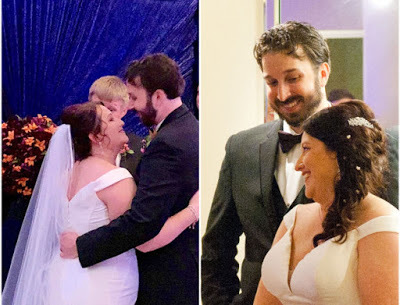

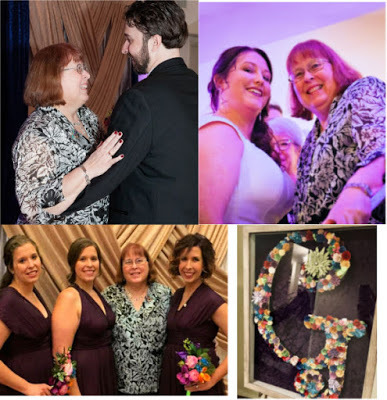

And now on to the writing portion of this post!
When crafting a scene, one key task for the writer is to make certain the reader can visualize the ‘where’ and ‘what’ surrounding and infusing your action. How do you do that? By focusing on the details of course.
As writers, we all aspire to create a compelling emotional response and a clear mental picture that will stay with readers long after they finish the last page. Memorable characters and powerful scenes are achieved through vivid writing.
But what is vivid writing? You may recognize it when you see it, but do you know how to create those same distinct images on the pages of your own manuscript?
Here are some things to think about when crafting (or editing) your scenes that I believe will help you start on the path to more vivid writing.
ENVIRONMENTWhat is the weather/temperature/climateWhat kind of lighting is presentWhat time of day is itWhat time of year is it
SETSIf your character is indoors :What is the type and size of the room/enclosure she is occupying?How is it furnished?If your character is outdoors:What is the terrain (hilly, marshy, rocky, lush, dusty, etc)?What plants, insects, animals, structures are visible?If your character is in a vehicleWhat is the type of vehicle?Is it well maintained or falling apart?Is it still or in motion?What view of the outside world is available?What is the look and feel of the interior?What are the occupants’ comfort level?
ATTIRE Think of your characters’ garments in the following terms:Fit - are they restrictive, flowing, form-fitting, oversizedFabric - is the touch smooth or textured, does it rustle, scratch, caress, is it heavy or lightCondition - are they new, old, torn, worn, clean, soiled, crisp, limp, wrinkled Style - would the look be described as classic, chic, dated, formal, casual, businesslikeColor - bright, muted, flashy, print, solid, clashing, coordinatedAccessories - hats, handbags, belts, jewelry, shoes, gloves
USE OF FIVE SENSES
What can each character see?What can each character hear?What can each character smell?What can each character taste? (don’t forget - this can be internal, such as bile rising in the throat or blood from a cut lip)What can each character physically feel/touch
PHYSICAL PRESENCEWhere are the characters in relation to each other? Did you remain true to this throughout the scene ? (i.e.: he can’t see that she’s wrinkling her nose if her back is to him) How would you describe their general appearance Do they appear neat, disheveled, comfortable? Are they wearing make-up, glasses, five o’clock shadow? Is their hair up, slicked back, braided, loose? Speech patterns and tone Is your characters’ voice soft, abrasive, throaty, sibilant, whiny? Do they use colloquialisms, clichés, ostentatious words, catch phrases? Are they exhibiting any nervous/unconscious mannerisms?What are they doing with their upper body - hand gestures, fingers drumming, head movements, facial expressions, stiff-backed posture, slumped shoulders, bobbing adam’s apple, heaving chest?What are they doing with their lower body - sitting, crouching, limping, pacing, legs crossed, legs swinging, foot tapping?Which character dominates the stage? Can the scene be improved if someone else took the spotlight?Who is your Point Of View character? Can the scene be improved by changing this?EMOTIONS
What emotions are each of your characters experiencing inwardly?What emotions are each of your characters expressing outwardly?How attuned is each character to the emotions and nature of the other characters around him/her?
MISCIs there something you can do to heighten the physical awareness/sexual tension of this scene?Can you throw bigger obstacles at your characters or otherwise heighten the conflict in this scene?Is there any foreshadowing you can do of the secrets your characters are hiding, or of pivotal scenes to come?Have you made the best word choices to provide the pacing and convey the mood, level of tension and nuances of character you desire?
Caution: You won’t need, or even want, to use every element on the list in each scene. Rather, carefully pick those nuggets that are most significant to the particular scene you are working on, providing the punch and nuances you wish to convey.
Once you’ve selected the details you wish to use, you must determine how to reveal them. Your goal should be to weave them into the story in such a way as to maximize their impact without slowing the pace.
A few techniques to consider are listed below:
Unfold the setting through your character’s action.
Most people don’t enter a new environment and absorb everything immediately. Just so, don’t stop the action of your scene by dumping in a block of description all at once. Let your character notice things as he moves across the stage: how he must step around the massive planter as he crosses the patio, how her finger leaves a trail across the dusty desk, how uncomfortable he is negotiating around the knick-knack cluttered room.
Filter the setting through your character’s background and life experiences.
Would a ten year old be more likely to focus on the style of furniture in the room or on the collection of antique toys just out of her reach? When a techno-geek enters a hotel room, will he look first for the view from his balcony or the computer connectivity options?
Color the setting through your character’s emotions and senses.
Is your character happy, afraid, bitter, heartbroken, in pain? Those emotions will influence how he perceives the things around him. For instance, the same rainstorm can be viewed by two people, but one sees it as a disaster because it means a cancelled outing, while the other views it as a godsend because it ends a drought that could have spelled financial disaster. In the same way, the scent of a particular perfume can evoke cherished memories of a lover, or painful memories of an abusive parent.
There you have it. Apply these techniques to your scenes and you’ll be on your way to making each one a sensory delight for your readers.

So what do you think - was this checklist helpful? Do you have a checklist of your own that you use? Please do share. And I'll be giving away a copy of the rerelease of my book The Christmas Journey, part of a new 2-in-1 collection from Love Inspired, to one person who leaves a comment on this post.

Published on October 18, 2018 21:30
October 16, 2018
A Branding Primer
This great post was pulled from the archives so y'all can brush up on branding! Our guest Laurie Tomlinson is providing a new giveaway today and working on a brand new post to share with us next month.

Thank you so much, Seekers, for inviting this self-professed marketing geek to talk about one of my favorite subjects. Let’s get to it, shall we?
What is Branding and Why Is It Important?
 I love marketing guru Seth Godin’s definition:
I love marketing guru Seth Godin’s definition:
“A brand is the set of expectations, memories, stories, and relationships that, taken together, account for a consumer’s decision to choose one product or service over another.”
Many people mistake a cohesive style for brand, and while it’s an important component, it’s only a small part of it.
Branding is the collective story you tell industry professionals and readers about you and your work. It’s what sets you apart from other authors, not in a dog-eat-dog kind of way, but in a way that represents the unique aspects that make you *you*. It’s how, when readers are scrolling through their social media, they can tell a post is from you even before they see your name.
Identifying the Vision and Mission of Your Brand
While an author tagline is great because it tells the audience what they can expect up front, knowing the vision and mission behind your work is most crucial. Everything we write, from the pages of our books, to our query letters, to the tone and content of our social media should tell that for us.
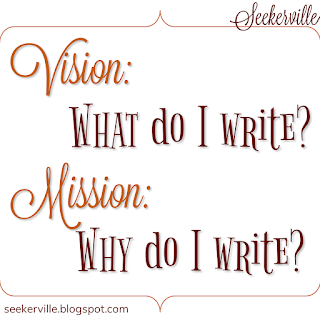 Vision answers the question: What do I write?
Vision answers the question: What do I write?
Mission answers the question: Why do I write?
So if, for example, you write authentic women’s fiction (what) to give readers hope through relatable characters (why), your blog posts will be hope-filled, your voice authentic, and your content primarily centered around women.
Many of us who are doing our heart’s work have huge heart-dreams and run into a snag when trying to be succinct in the themes/topics we cover, but inconsistency will only confuse readers and detract from our message. To create a more defined brand vision and mission, we should go with our strongest values and the characteristics we can see being most cohesive across our unique body of work.
Identifying Our Audience
A huge key to brand is identifying our audience. This is the person who will benefit the most from our work. One thing I’ve always encouraged clients to do is to name the person they’re writing for. Mine is Meg. It may sound kind of weird—especially if you talk about this pretend person in a pitch appointment (cough, or so I’ve been told)—but we all create and talk to imaginary people, so let’s go with it.
Just as we research and profile characters before beginning a new project, it’s important to know and identify as much as possible about our ideal audience. Of course, our work will naturally appeal to a broader range of people, but if we write for anyone and everyone who will listen, our message as a whole will be watered down, and our potential for impact will suffer.
At the very least, identifying age, gender, and what makes this person click a link or pick up a book can be helpful. If you write for more than one genre, then look for the common denominators in your audience and refine from there.
But most importantly, research what your audience needs the most from you. Is it hope? Entertainment? Solidarity? Authenticity? Hopefully, this lines up with the why of your vision and what you uniquely have to offer.

Once you've determined your ideal audience, every branding decision should consider that person. I know it sounds like a lot of work, but you will soon develop an instinct for what (and where) you write, the tones you use, and the messages you send. And your intentionality with your brand will result in the reward of a more meaningful conversation between you and your audience.
A Case Study: In my debut novel,
With No Reservations
In my debut novel,
With No Reservations
 , my heroine Sloane is a popular food blogger who knows a lot about branding and reaching her ideal audience. Her website is called Mise en Place, a French culinary term for assembling ingredients prior to cooking. The photos she uses have distinctive color contrast and always feature shots of the recipe ingredients neatly (and appetizingly!) arranged.
, my heroine Sloane is a popular food blogger who knows a lot about branding and reaching her ideal audience. Her website is called Mise en Place, a French culinary term for assembling ingredients prior to cooking. The photos she uses have distinctive color contrast and always feature shots of the recipe ingredients neatly (and appetizingly!) arranged.
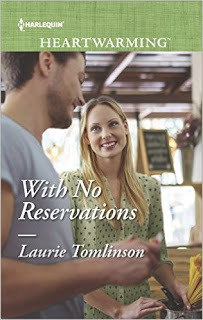 All of her design decisions and word choices reflect an approachable, organized, and beautiful cooking experience because that’s what her audience needs for recipe inspiration.
All of her design decisions and word choices reflect an approachable, organized, and beautiful cooking experience because that’s what her audience needs for recipe inspiration.
Sloane writes to give accessible, step-by-step recipes to home cooks who want to mix up their rotation. Her ideal reader, a busy 30-year-old housewife named Michelle who found her on Pinterest, is attracted to a recipe post because of its beautiful pictures, knows it’s from Sloane because of her unique style of photos, and comes back to the website because the step-by-step format of the recipes makes her feel like she can try anything.
While Sloane’s recipe posts naturally attract a broader audience—men who love to cook, 20-year-olds who are getting their first apartments, and other cooking enthusiasts—the style and content decisions she makes stay true to her vision and what’s accessible and appealing to Michelle. Sloane regularly gauges this, and may shift and adapt things according to the conversation and reader feedback her content generates.
So, to sum things up, it's simple. Once you’ve refined the vision and message for your author brand, the more you will know about your ideal audience. And the more you know about your person, the easier your decisions will be and the more your content will resonate.
What and who are you writing for? Is there an author you can think of with a distinctive brand?
 Two childhood sweethearts. One failed summer romance. Twelve years later.
Two childhood sweethearts. One failed summer romance. Twelve years later.
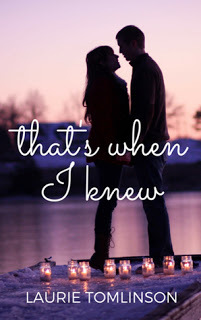 On most days, Chelsea Scott feels like her rapidly growing planner and stationery business should belong to someone else. Maybe if it did, it wouldn't be hovering near the red due to one costly decision. But the collaboration that will save her company awaits her pitch at the trade show she's keynoting. When her transportation falls through at the last minute, she accepts help from Nick Pearson, who’s unexpectedly come back into her life.
On most days, Chelsea Scott feels like her rapidly growing planner and stationery business should belong to someone else. Maybe if it did, it wouldn't be hovering near the red due to one costly decision. But the collaboration that will save her company awaits her pitch at the trade show she's keynoting. When her transportation falls through at the last minute, she accepts help from Nick Pearson, who’s unexpectedly come back into her life.
The last time Nick saw Chelsea, he told her he loved her, and she ran. Twelve years later, their lives are different, more complex than the summers they spent playing baseball and eating ice cream cones at their dock with their toes in the lake. But as they spend time together on the road, their feelings for each other become clear: all those years couldn’t take away how good they can be together.
When Chelsea's past decisions resurface at the convention, her newly rekindled relationship with Nick – and her business – are in jeopardy. Will their love be enough to keep them together or will another summer end with them apart?
Goodreads | Amazon
Leave a comment today for an opportunity to win
an ebook copy of That's When I Knew. OR pick up your own copy at just $0.99 for a limited timeWinner announced in the Weekend Edition.
 Laurie Tomlinson is a wife and mom from Tulsa, Oklahoma, who enjoys stories of grace in the beautiful mess. She is a member of the American Christian Fiction Writers and regular contributor to The Writers Alley Blog. Her work is represented by Rachel Kent of Books & Such Literary, has won two Genesis Awards, and was runner-up in the 2015 RWA Lone Star Contest.
Laurie Tomlinson is a wife and mom from Tulsa, Oklahoma, who enjoys stories of grace in the beautiful mess. She is a member of the American Christian Fiction Writers and regular contributor to The Writers Alley Blog. Her work is represented by Rachel Kent of Books & Such Literary, has won two Genesis Awards, and was runner-up in the 2015 RWA Lone Star Contest.
Website | Facebook | Twitter | Instagram

Thank you so much, Seekers, for inviting this self-professed marketing geek to talk about one of my favorite subjects. Let’s get to it, shall we?
What is Branding and Why Is It Important?
 I love marketing guru Seth Godin’s definition:
I love marketing guru Seth Godin’s definition:“A brand is the set of expectations, memories, stories, and relationships that, taken together, account for a consumer’s decision to choose one product or service over another.”
Many people mistake a cohesive style for brand, and while it’s an important component, it’s only a small part of it.
Branding is the collective story you tell industry professionals and readers about you and your work. It’s what sets you apart from other authors, not in a dog-eat-dog kind of way, but in a way that represents the unique aspects that make you *you*. It’s how, when readers are scrolling through their social media, they can tell a post is from you even before they see your name.
Identifying the Vision and Mission of Your Brand
While an author tagline is great because it tells the audience what they can expect up front, knowing the vision and mission behind your work is most crucial. Everything we write, from the pages of our books, to our query letters, to the tone and content of our social media should tell that for us.
 Vision answers the question: What do I write?
Vision answers the question: What do I write?Mission answers the question: Why do I write?
So if, for example, you write authentic women’s fiction (what) to give readers hope through relatable characters (why), your blog posts will be hope-filled, your voice authentic, and your content primarily centered around women.
Many of us who are doing our heart’s work have huge heart-dreams and run into a snag when trying to be succinct in the themes/topics we cover, but inconsistency will only confuse readers and detract from our message. To create a more defined brand vision and mission, we should go with our strongest values and the characteristics we can see being most cohesive across our unique body of work.
Identifying Our Audience
A huge key to brand is identifying our audience. This is the person who will benefit the most from our work. One thing I’ve always encouraged clients to do is to name the person they’re writing for. Mine is Meg. It may sound kind of weird—especially if you talk about this pretend person in a pitch appointment (cough, or so I’ve been told)—but we all create and talk to imaginary people, so let’s go with it.
Just as we research and profile characters before beginning a new project, it’s important to know and identify as much as possible about our ideal audience. Of course, our work will naturally appeal to a broader range of people, but if we write for anyone and everyone who will listen, our message as a whole will be watered down, and our potential for impact will suffer.
At the very least, identifying age, gender, and what makes this person click a link or pick up a book can be helpful. If you write for more than one genre, then look for the common denominators in your audience and refine from there.
But most importantly, research what your audience needs the most from you. Is it hope? Entertainment? Solidarity? Authenticity? Hopefully, this lines up with the why of your vision and what you uniquely have to offer.

Once you've determined your ideal audience, every branding decision should consider that person. I know it sounds like a lot of work, but you will soon develop an instinct for what (and where) you write, the tones you use, and the messages you send. And your intentionality with your brand will result in the reward of a more meaningful conversation between you and your audience.
A Case Study:
 In my debut novel,
With No Reservations
In my debut novel,
With No Reservations
 , my heroine Sloane is a popular food blogger who knows a lot about branding and reaching her ideal audience. Her website is called Mise en Place, a French culinary term for assembling ingredients prior to cooking. The photos she uses have distinctive color contrast and always feature shots of the recipe ingredients neatly (and appetizingly!) arranged.
, my heroine Sloane is a popular food blogger who knows a lot about branding and reaching her ideal audience. Her website is called Mise en Place, a French culinary term for assembling ingredients prior to cooking. The photos she uses have distinctive color contrast and always feature shots of the recipe ingredients neatly (and appetizingly!) arranged. All of her design decisions and word choices reflect an approachable, organized, and beautiful cooking experience because that’s what her audience needs for recipe inspiration.
All of her design decisions and word choices reflect an approachable, organized, and beautiful cooking experience because that’s what her audience needs for recipe inspiration.Sloane writes to give accessible, step-by-step recipes to home cooks who want to mix up their rotation. Her ideal reader, a busy 30-year-old housewife named Michelle who found her on Pinterest, is attracted to a recipe post because of its beautiful pictures, knows it’s from Sloane because of her unique style of photos, and comes back to the website because the step-by-step format of the recipes makes her feel like she can try anything.
While Sloane’s recipe posts naturally attract a broader audience—men who love to cook, 20-year-olds who are getting their first apartments, and other cooking enthusiasts—the style and content decisions she makes stay true to her vision and what’s accessible and appealing to Michelle. Sloane regularly gauges this, and may shift and adapt things according to the conversation and reader feedback her content generates.
So, to sum things up, it's simple. Once you’ve refined the vision and message for your author brand, the more you will know about your ideal audience. And the more you know about your person, the easier your decisions will be and the more your content will resonate.
What and who are you writing for? Is there an author you can think of with a distinctive brand?
 Two childhood sweethearts. One failed summer romance. Twelve years later.
Two childhood sweethearts. One failed summer romance. Twelve years later. On most days, Chelsea Scott feels like her rapidly growing planner and stationery business should belong to someone else. Maybe if it did, it wouldn't be hovering near the red due to one costly decision. But the collaboration that will save her company awaits her pitch at the trade show she's keynoting. When her transportation falls through at the last minute, she accepts help from Nick Pearson, who’s unexpectedly come back into her life.
On most days, Chelsea Scott feels like her rapidly growing planner and stationery business should belong to someone else. Maybe if it did, it wouldn't be hovering near the red due to one costly decision. But the collaboration that will save her company awaits her pitch at the trade show she's keynoting. When her transportation falls through at the last minute, she accepts help from Nick Pearson, who’s unexpectedly come back into her life.The last time Nick saw Chelsea, he told her he loved her, and she ran. Twelve years later, their lives are different, more complex than the summers they spent playing baseball and eating ice cream cones at their dock with their toes in the lake. But as they spend time together on the road, their feelings for each other become clear: all those years couldn’t take away how good they can be together.
When Chelsea's past decisions resurface at the convention, her newly rekindled relationship with Nick – and her business – are in jeopardy. Will their love be enough to keep them together or will another summer end with them apart?
Goodreads | Amazon
Leave a comment today for an opportunity to win
an ebook copy of That's When I Knew. OR pick up your own copy at just $0.99 for a limited timeWinner announced in the Weekend Edition.
 Laurie Tomlinson is a wife and mom from Tulsa, Oklahoma, who enjoys stories of grace in the beautiful mess. She is a member of the American Christian Fiction Writers and regular contributor to The Writers Alley Blog. Her work is represented by Rachel Kent of Books & Such Literary, has won two Genesis Awards, and was runner-up in the 2015 RWA Lone Star Contest.
Laurie Tomlinson is a wife and mom from Tulsa, Oklahoma, who enjoys stories of grace in the beautiful mess. She is a member of the American Christian Fiction Writers and regular contributor to The Writers Alley Blog. Her work is represented by Rachel Kent of Books & Such Literary, has won two Genesis Awards, and was runner-up in the 2015 RWA Lone Star Contest.Website | Facebook | Twitter | Instagram
Published on October 16, 2018 21:00
October 14, 2018
What Are Your True Goals?

by Jan Drexler
I’ve had a lot of time to think lately.
My husband, our youngest son, and I returned home yesterday after a ten-day trip East to visit family. I also spent some time researching my next story, chatting with readers, and visiting my publisher.
During our forty-four-plus hours in the car, I did a lot of thinking about writing: future stories, my work-in-progress, blog posts, my career goals.
I also spent time reflecting on the last eight whirlwind years. What has happened during those years?
I’ve achieved my goal of writing and finishing a full-length novel. I’ve achieved my goal of being a published author. I’ve achieved my goal of writing for my dream publisher. I’ve achieved my goal of seeing my book on the shelves of my local library. I've achieved my goal of writing ten books.
What comes next?
Let me tell you what I was thinking about during that forty-four-plus-hour car ride…
If these had been the only goals for my life, I would be done.
If I had made the mistake of focusing on these goals to the exclusion of everything else, I would be finished.
And I can’t help thinking that if I had never looked beyond these goals, I would be looking forward to a lot of empty years ahead.
But these are NOT my only goals.
I am VERY thankful to have been given the opportunity to write and to share my stories with others, but this isn’t my life.
I am not defined by my writing.
What does define me?
1) I am a child of God.
2) I have a purpose in my life: To glorify God and enjoy Him forever.
3) I have the opportunity to use the talents He has given me to serve Him and achieve that purpose.
So my goal – the theme of my life – is to glorify God.
Everything else is a means to that end.
* * * * * * * * * * * *
Count to ten.
* * * * * * * * * * * *
Let that sink in.
* * * * * * * * * * * *
Everything in my life is an opportunity to glorify God.
Even if I had never achieved any of the goals I listed above, my purpose would not have changed. If I had never written a word, my purpose – my chief goal – would remain the same.
If I had never finished a book, landed my agent, or signed a publishing contract…my life would still have meaning and purpose.
My desires (plans, goals, wishes) often go unfulfilled. Many times when I have prayed for something, God has said "no," or "not yet." Those are the times when I must remind myself that I have not planned this life, but God has. And His plans are always perfect.
The challenge is to remain content no matter what path God leads me down...and that must be my true goal.
I hope I didn't wax too philosophical today! But I wonder if you've been thinking about the same kinds of things.
If you would like to, share with the rest of us:
What are your goals?
Are you defined by those goals?
What are your goals beyond the one you’re working toward right now?
Comment to be included in the drawing for a copy of my latest release, The Sound of Distant Thunder.
Published on October 14, 2018 21:00



